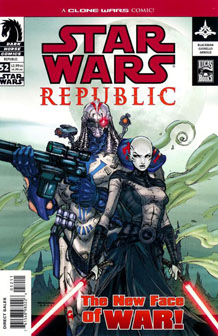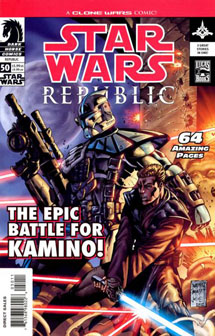Begun, the Clone Wars did, in Dark Horse Comics with “Star Wars: Republic” Issues 49-59 in 2003. This the start of what I call Phase I of the Clone Wars, with Phase II being the 2008-14 TV series (and related books and comics) with Ahsoka Tano as Anakin’s Padawan. While I prefer Phase II, Phase I has a lot to offer as well, and it shouldn’t be forgotten.
The 2003 batch of comics is a mixed bag, with primary writer John Ostrander delivering his usual standout tales and secondary writer Haden Blackman pitching in more generic war tales. Whereas the post-“Episode I” comics for some reason shied away from using Anakin and Obi-Wan, the post-“Episode II” comics thankfully do not. Equally good news is that the post-“Episode I” characters we came to love are also still in the game – in fact, Ostrander kicks off the Clone Wars by catching readers up with Quinlan Vos.
In “Sacrifice” (49) and “Double Blind” (54), we learn that Quinlan – who had already straddled the light and dark sides in previous yarns – has already spent two years infiltrating the forces of what is now called the Confederacy of Independent Systems (a.k.a. the Separatists). As is becoming a pattern with Quinlan stories, the Jedi Council becomes concerned and sends his former Padawan Aayla Secura to check in on him. Quinlan’s love interest Khaleen is a nice addition, and “Double Blind” concludes with a twist that will be expanded on in future stories: Quinlan’s mission, as approved by the Jedi Council (and in a repeat of what Luke does in “Dark Empire”), is to pretend to go to the dark side and join Dooku.
It’s too bad that Quinlan’s arc is peppered here and there rather than being solid four-issue arc like “Republic” used to do, but I can’t blame Dark Horse for wanting to quickly get Anakin and Obi-Wan into the action. While “Clone Wars” Season 4 made a big deal about returning to Kamino, Dark Horse actually got there years earlier in the oversized 50th issue, “The Defense of Kamino.” The Separatists wisely aim to wipe out the clone factories, but they are made to fail because Sidious wants to prolong the war.
“The Defense of Kamino” is split into three stories. In Ostrander’s “Brothers in Arms,” Anakin rescues Obi-Wan from a Kaminoan ocean monster and they resolve some of their lingering tension from “Attack of the Clones”; Blackman’s “Jango’s Legacy” is the first story to prominently feature a clone, the Jango-esque A-17, from the Alpha batch; and Scott Allie’s “No End in Sight” features the demise of a Separatist group of Mon Calamari – an unusual choice considering that species is on the side of the Republic in Season 4 of “The Clone Wars.” Speaking of Anakin’s lingering issues from “Episode II,” he clashes with A’Sharad Hett in Ostrander’s “Enemy Lines” (59), because A’Sharad is a Tusken Raider and Tusken Raiders killed Anakin’s mom.


The other issues in this batch come from Blackman, and they tend to be more about war than characterization. Granted, he does introduce Asajj Ventress and General Durge in “The New Face of War” (51-52), but Durge is a cartoonish invincible thug and Ventress – later to become a beloved character in “The Clone Wars” — is rough around the edges. Her belief (a mirror of Dooku’s) is that she is a genuine Jedi and the Jedi Council has lost its way, and she constantly calls Obi-Wan “False Jedi.” “Blast Radius” (53) is a prototypical “cost of war” Clone Wars yarn in that we see the demises of “legendary” Jedi Masters Knol Ven’nari, Jon Antilles, Nico Diath and Fay – but you’re excused if you don’t remember any of them.
Blackman’s epic “The Battle of Jabiim” (55-58, a rare exception to “Republic’s” eschewing of multi-part stories after “Episode II”) is even more of a bloodbath. It’s a confusing, rain-soaked tale for three issues, but it gets weirdly interesting in the final chapter when Anakin — in a rare case of following orders — abandons a bunch of Padawans in order to rendezvous at a clone-trooper pick-up site. Soon after we see the Padawans mowed down by Separatists, Anakin – again, following orders – abandons Jabiim’s outnumbered Republic loyalists to their fates, and the leader of the loyalists vows revenge on Anakin and the Republic. Anakin later tells Supreme Chancellor Palpatine: “The Battle of Jabiim is over. We lost. We all lost.” But it’s worse than that, as the Republic seems to have created a new enemy. I appreciate Blackman’s final statement, as it works as a commentary on U.S. foreign intervention. But it doesn’t salvage the whole tale, especially since Anakin is so out of character at the end.
Oh, and I almost forgot about this major plot point because it’s so underplayed: Anakin thinks Obi-Wan is dead throughout most of “The Battle of Jabiim,” presuming he died in an AT-AT explosion at the end of Issue 55. Blackman doesn’t play up Anakin’s grief too much, though, and as we learn at the end of Issue 59, Obi-Wan was captured by Ventress off-panel.
Overall, the first year of the Clone Wars in “Republic” is a mixed bag: It effectively shows the confusion and costs of war, and the various ways Palpatine manipulates battles toward his preferred outcome. But it doesn’t yet have a great handle on Obi-Wan’s and Anakin’s roles as generals who are well-respected by clones. Durge and Ventress are present, but they aren’t yet good characters – I don’t think Durge ever becomes compelling, but I know Ventress will. And Quinlan is only dipping his toes into what should be his best storyline yet.

